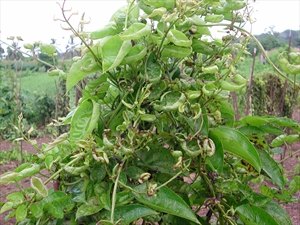Yam dieback, yam anthracnose, lightning disease of yam
Pacific Pests, Pathogens, Weeds & Pesticides - Online edition
Pacific Pests, Pathogens, Weeds & Pesticides
Yam anthracnose & dieback (016)
Glomerella cingulata (it is also known as Colletotrichum gloeosporioides, the asexual state of the fungus). Glomerella is the sexual state of the fungus.
Anthracnose and dieback occurs wherever yams (Dioscorea alata) are grown. The disease is recorded from Fiji, Papua New Guinea, New Caledonia, Niue, Samoa, Solomon Islands, Tonga, and Vanuatu.
There are many strains of Colletrotrichum gloeosporioides attacking crops and weeds. Some strains infect several hosts. Yam (Dioscorea alata) is a major host; other yams, for instance, Dioscora esculenta, Dioscorea bulbifera, Dioscorea nummularia and Dioscora rotundata-cayanensis (African yam) show mostly minor leaf spot infections.
Symptoms depend on rainfall and the susceptibility of varieties. On young leaves, the spots enlarge rapidly and often join together (Photo 1). On older leaves, pinpoint spots develop that do not expand. Usually, the young, infected leaves fall early.
On some varieties, only the young veins are infected; in this case, the leaves become cup-shaped as they expand (Photo 2).
On some (early) varieties, large numbers of spores on the old leaves cause the leaves to turn black when they are exposed to sunlight (Photo 3). This causes the blackening that occurs after long periods of rain.
The source of the fungus is not known for certain. There are three possibilities: (i) it is in the soil; (ii) it is in the planting material; (iii) it comes from other plants, weeds or crop plants. In the Caribbean, tubers are infected and these are a source of the fungus. This is less certain in Pacific island countries, but the fungus has been found on other crops and weeds, and these are thought to be major sources of infection for yam dieback.
Spores are produced in tiny, dish-like structures in the spots and are splashed by rain onto other leaves and stems. They germinate, infect and produce more spots and spores. On older leaves, they germinate, but do not infect or only produce pinpoint spots.
The fungus is damaging during wet weather. Leaf spots occur and these produce masses of spores. On susceptible varieties, leaves quickly turn black during long periods of rain. Shoots are destroyed and the stems die back. New shoots grow from the planting piece, but these, too, become black and die back. Plants can be killed without producing tubers or each shoot produces several small tubers before it dies.
The blackening is so sudden on some varieties of yam that farmers say the yams have been struck by lightning.
Dieback is one of the reasons why yam is declining in popularity.
Look for brown leaf spots on young leaves, sometimes with a yellow halo. Look for plants where older leaves go black after long periods of rain. Look for vines that die back, only to sprout again from the planting piece.
CULTURAL CONTROL
Before planting:
- Plant early, in August and September, so that plants are at the tops of their supporting poles before the storm season. This is the most important control measure.
- Check each planting piece for rot. If rots are found cut them out and then wipe the knife with bleach before using it to cut pieces from other tubers.
During growth:
- These suggestions have been made, but their usefulness is not proven:
- Do not weed when the plants are wet to avoid shaking spores from infected to healthy leaves and stems.
- Interplant with maize; presumably this is to increase the spacing between plants.
- Avoid damage to the tubers at harvest to avoid infection of tubers by spores of Colletotrichum.
After harvest:
- Collect and burn or bury debris after harvest.
- Do not plant yams in the same land as the last crop. Leave a break of 3 years.
RESISTANT VARIETIES
Varieties differ in resistance to the disease; some are resistant at all stages of growth, others only when mature and have a full canopy. Therefore, select those that show resistance/tolerance. Unfortunately, the most susceptible are those most valued for earliest and taste.
If growers want to plant susceptible varieties, separate them from those that have some tolerance to the disease. If planted together, not only is there a chance that the disease will destroy susceptible varieties, but also disease pressure will be greater on the tolerant ones.
CHEMICAL CONTROL
Although fungicides, for instance, benomyl (no longer recommended), chlorothalonil, copper, dithiocarbamates (e.g., mancozeb) have been recommended in Pacific and Caribbean islands, they can only delay the start of an epidemic. They are not effective during long rainy periods.
____________________
When using a pesticide, always wear protective clothing and follow the instructions on the product label, such as dosage, timing of application, and pre-harvest interval. Recommendations will vary with the crop and system of cultivation. Expert advice on the most appropriate pesticide to use should always be sought from local agricultural authorities.
AUTHORS Helen Tsatsia & Grahame Jackson
Information from Winch JE, et al. (1984) Studies on Colletotrichum gloeosporioides on yam, Dioscorea alata, in Solomon Islands Plant Pathology 33(4): 467-477. (https://doi.org/10.1111/j.1365-3059.1984.tb02870.x).
Produced with support from the Australian Centre for International Agricultural Research under project PC/2010/090: Strengthening integrated crop management research in the Pacific Islands in support of sustainable intensification of high-value crop production, implemented by the University of Queensland and the Secretariat of the Pacific Community.






